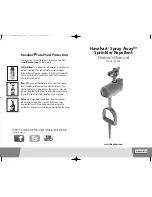
Cap will prevent proper opera-
tion of the Sprinkler.
7. When using the Push-on Escutch-
eon Plate alone, align the two slots
on the inside edge of the Push-on
Escutcheon Plate with the Wrench
Lugs on the Sprinkler Body and then
push the Escutcheon Plate over the
Body of the Sprinkler until its outside
edge comes in contact with the
mounting surface.
When using the Push-on Plate with
Extension, first determine the dis-
tance from the wall mounting sur-
face to the outside of the Heat Col-
lector. If the dimension is 1-1/8
inches or less, discard the Extension
and proceed to install the Push-on
Plate as indicated above. If the di-
mension is greater than 1-1/8
inches, assemble the Extension to
the Push-on Plate and then proceed
to install the assembly as indicated
above.
NOTE
Do not attempt to make-up for
insufficient adjustment in an
Escutcheon Plate by under- or
over-tightening the Sprinkler.
Readjust the position of the
sprinkler fitting to suit.
CARE AND MAINTENANCE
The Model F993 Sprinklers must be
maintained and serviced in accord-
ance with the following instructions:
NOTES
Absence of an Escutcheon Plate
may delay the time to sprinkler
operation in a fire situation.
Before closing a fire protection
system main control valve for
maintenance work on the fire pro-
tection system which it controls,
permission to shut down the af-
fected fire protection systems
must be obtained from the proper
authorities and all personnel who
may be affected by this action
must be notified.
Particular care to prevent over-
heating must be exercised when
storing sprinklers in cars, trucks,
trains, or other vehicles on warm,
bright sunny days.
Sprinklers which are found to be leak-
ing or exhibiting visible signs of cor-
rosoin must be replaced.
Automatic sprinklers must never be
shipped or stored where their tempera-
ture will exceed 100°F/38°C and they
must never be painted, plated, coated,
or otherwise altered after leaving the
factory. Modified or over-heated sprin-
klers must be replaced.
Care must be exercised to avoid dam-
age to the sprinklers - before, during,
and after installation. Sprinklers dam-
aged by dropping, striking, wrench
twist/slippage, or the like, must be re-
placed.
The owner is responsible for the in-
spection, testing, and maintenance of
their fire protection system and de-
vices in compliance with this docu-
ment, as well as with the applicable
standards of the National Fire Protec-
tion Association (e.g., NFPA 25), in
addition to the standards of any other
authorities having jurisdiction. The in-
stalling contractor or sprinkler manu-
facturer should be contacted relative
to any questions.
It is recommended that automatic
sprinkler systems be inspected,
tested, and maintained by a qualified
Inspection Service.
The F993 Sprinklers must only be re-
placed with pendent sprinklers which
are listed for residential fire protection
service and which have the same
nominal K-factor, the same coverage
area, and the same or lower flow rat-
ings (as indicated under “Hydraulic
Design Criteria”).
All residential sprinklers installed
within a compartment (as defined by
the NFPA) must have the same heat
response thermal characteristic, and
their temperature ratings are to be
within 10°F of each other.
NOTES
Wet pipe sprinkler systems must
be maintained at a minimum tem-
perature of 40F/4C. Exposure to
freezing temperatures can result
in bursting of the pipe and/or
sprinkler.
Do NOT enclose sprinklers within
drapes, curtains, or valances.
Do NOT hang anything from the
sprinklers.
Automatic sprinklers are NOT to
be tested with a heat source. Op-
eration of the heat responsive
element (Bulb) can result.
Do NOT cleanse the sprinklers
with soap and water, detergents,
ammonia, cleaning fluids, or
other chemicals. Remove dust,
lint, cobwebs, cocoons, insects,
and larvae by gently brushing
with a feather duster or gently
vacuuming with a soft bristle (i.e.,
dusting) brush attachment.
The minimum vertical clearance
between the tops of free standing
partitions, room dividers, cab-
inets, storage racks, stock piles,
etc., and the sprinkler deflector is
NOT to be less than the clearance
given below.
Horizontal Distance Vertical
from Sprinkler
Clearance
to Item, ft.
In.
More than 9 . . . . . . . 40
From 6 to 9 . . . . . . . . 32
Between 3 and 6 . . . . . 26
3 or Less . . . . . . . . . 18
Exercise suitable safety precau-
tions in the use and storage of
highly flammable and potentially
explosive materials. The rapid
rate of fire development and
spread which can be caused by
such materials can reduce the
ability of the sprinkler system to
aid in the control of a fire in
which they are involved.
—6—
OBSOLETE
Summary of Contents for AQUARIUS F993
Page 8: ...O B S O L E T E...


























